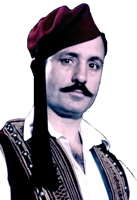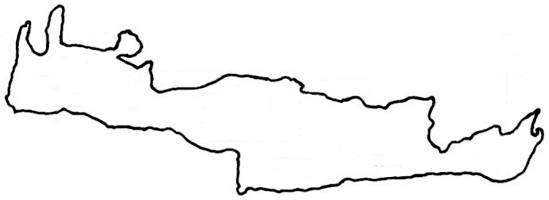
|
The Society of Folk Dance Historians (SFDH)
The Cretan Passion for Dance
[
Home |
About |
Encyclopedia | CLICK AN IMAGE TO ENLARGE |

|
BACKGROUND
 Information: The diversity of Greek folk expressions is more evident on the island of Crete than anywhere else in Greece. Cretans are quick to point out that tales of Greek mythology refer to the Cretan art of dance. Rhea, wife of Kronos, taught dance to the sons of Earth – Kouretes of Crete – as well as to the Corybants of Phrygia in Asia Minor. In order to secure his throne, Kronos devoured his children at birth. Overwhelmed with grief, Rhea fled to the Mountain Psiloritis (Mt. Ida) in Crete where she gave birth to Zeus, and to prevent Kronos from hearing her baby cry, she pleaded with the Kouretes to dance wildly and noisily around the baby's golden cradle, beating their bronze shields with their swords and stamping their feet.
Information: The diversity of Greek folk expressions is more evident on the island of Crete than anywhere else in Greece. Cretans are quick to point out that tales of Greek mythology refer to the Cretan art of dance. Rhea, wife of Kronos, taught dance to the sons of Earth – Kouretes of Crete – as well as to the Corybants of Phrygia in Asia Minor. In order to secure his throne, Kronos devoured his children at birth. Overwhelmed with grief, Rhea fled to the Mountain Psiloritis (Mt. Ida) in Crete where she gave birth to Zeus, and to prevent Kronos from hearing her baby cry, she pleaded with the Kouretes to dance wildly and noisily around the baby's golden cradle, beating their bronze shields with their swords and stamping their feet.
Cretans also claim Greek dance stems from the vestiges of the early Minoan civilization and they have continued with an obstinate passion to carry on these traditions of music, song, and dance through the ages; persisting defiantly against a variety of invaders who ruled over this turbulent island.
This soul of Crete is harbored on the Mountain Psiloritis. On my very first visit to Crete, when transportation was not as nearly available, we hiked for miles from one ancient city to another through rough and uneven terrain. At a brook, we took a dip to refresh ourselves from the hot burning sun. Around the edges of the water there were long tender green shoots of grass resembling fine hair. A shepherd standing by informed us that these were the hairs from the beard of Zeus! One day, he said, as Zeus leaned over to take a drink, his face brushed along the side of the brook leaving part of his beard behind. It's fascinating to note how deep the psyche of the Cretan peasantry is rooted to the legends of the past.
At any social gathering in Crete – feast or celebration – dancing is the central attraction. The event begins with the eerie sounds of deliberate virtuoso warm-ups on the lyra (a pear-shaped, three-stringed bowed musical instrument) and soon the bellowing laouto (a long-neck fretted instrument) joins in to the cadenced rhythms as the lyra player – resembling the myghological Orpheus – sings traditional couplets known as "mandinades." Historians have theorized that these rhapsodized couplets were sung for thousands of years – an oral tradition similar to how the Iliad and Odyssey were transmitted. Every Cretan glendi (party) always begins with the processional Siganos dance. Here, the lyra player often acts like a pied piper by playing the role of interpreter as he improvises lyrically; singing jesting couplets that inform those gathered of news or social events. The dancers join in the singing by echoing the couplets during this slow-paced dance.
The most distinctive feature that signifies Cretan dance is the execution of the zales (steps) affecting the intricacy of the basic step in each style. The lead dancer is expected to show tsakisma (individualized steps), such as the kokkalia (bone) depicting the closeness of the feet as if cracking anklebones. These nuances show the reverence each dancer has as they execute a unique kokkalia while still retaining the intrinsic style of the dance. It is by these qualities that local distinctions are made and within seconds of watching anyone dance, Cretans can immediately pronounce where they hail from.
The town of Chania is known for its syrto (dragging) dances. The Haniotiko Syrto has become a Cretan trademark together with the Rethymniotiko and Messaritiko Syrto. The leaping Kastrinos dance from Iraklion – often confused with the Pidiktos – is similar to the Maleviziotikos that is danced in Malevizi. But the dance that most exemplifies the spirit of Crete is the Pentozali. This intriguing fast-paced "dizzy stepping" dance, named after the pente zales (five steps), is danced with varying rhythmic interperetation. Researcher Lillian Lawler thought it to be a remnant of the "dance of the Kouretes" in which purposeful leaping steps were attempting to "quicken" the growing force in nature to induce fertility.
From ancient times to the present, the Cretans' passion for life is reflected in their dance. Their vitality and exuberance extends through all generations with vibrant determination steeped in folk traditions that have been around longer than time.
DOCUMENTS
- Athan Karras, an article.
- Cretan Affair, an article.
- Crete, a region.
- Greece, a country.
This page © 2018 by Ron Houston.
Please do not copy any part of this page without including this copyright notice.
Please do not copy small portions out of context.
Please do not copy large portions without permission from Ron Houston.